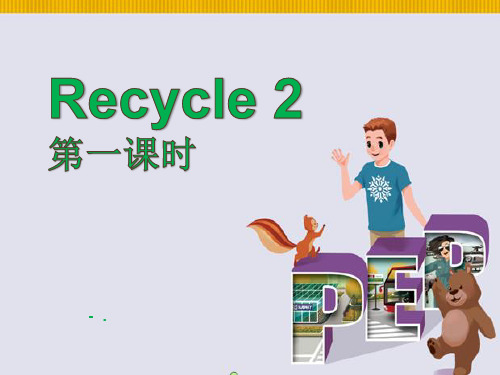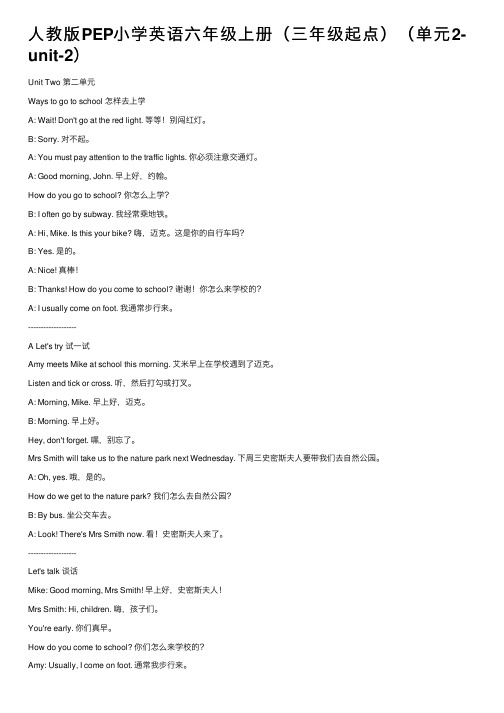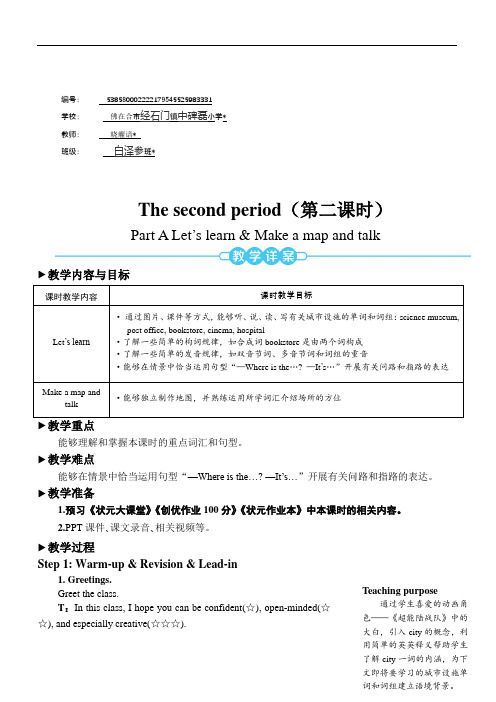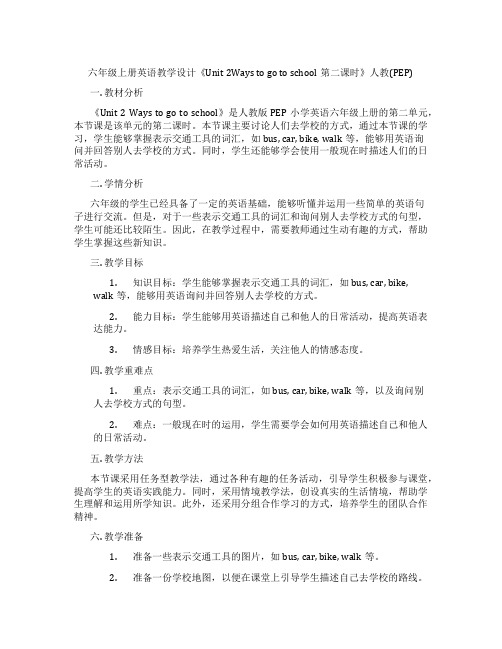PEP·六年级英语上册The second period(第二课时)
人教版PEP六年级英语上册《recycle2》PPT课件

Peter’s brother is piaying computer games. He is happy
Peter’s uncle is talking . He is happy. Peter is doing word puzzles. He is happy.
1. worried 3. ill
the most beautiful flower after three months a big red flower a small purple flower bring nothing the other two men feel ashamed
√
P66
1. two(序数词) _ 2. litle(比较级) __ 3. factory(复数)___ 4. fishing(原形)___ 5. teach(三单形式) __ 6. match(复数)___ 7. postman(对应词) _ 8. hiking(原形)____ 9. coach (复数) ____ 10.hobbies (单数) __
second less factories fish teaches matches postwoman hike coaches
hobby
P67
1. family(复数) _ 2. bus(复数) __ 3. running(原形)__ 4. aunt(对应词)___ 5. puzzles(单数) __ 6. know(同音词)___ 7. ill(反义词) ____ 8. bad(反义词)______ 9. good (副词) ____ 10.worry (形容词) __
听力原文:
My friend Kevin is a farmer. He has two boys and one girl. His little boy is called Ken. He is 11 years old. He likes singing. Ken’s mother is a worker in a milk factory. She likes reading. Ken’s brother is a fisherman. He likes fishing. His sister is a police officer. She likes doing Kungfu. She is really cool. Ken’s aunt teaches football. She likes watching football matches , too. His uncle is a postman , he likes going hiking every week .
人教版PEP六年级英语上册Unit2PartB课件

Read and write
Read the text and answer the questions. 1. How many ways to go to school can you find in the text?
_F__o_u_r._O__n__fo_o_t_,_b_y__sl_e_d_,_b_y__fe_r_r_y_a_n_d__b_y__p_la_n_e__. 2. Does everyone in the text go to school?
I must _fi_n_i_sh_ (finish) my homework.
文本解读
Don’t go at the red light! 别闯红灯! Don’t+动词原形(+其他)。 否定祈使句,用来提醒和警告别人不要做某事。
Don’t_c_r_o_s_s (cross) the road at the red light.
Let’s check
听力原文:
1. Wu Yifan: Excuse me. How can I get to the park? Post officer: Take the number 25 bus. Wu Yifan: Can I go on foot? Post officer: No. It’s too far. Go by bus.
Review
Look and read
by bike
by subway
by plane
by bus by taxi
on foot by ship
by train
Leght, Red light, stop and wait!
Yellow light, yellow light, slow down and stop! Green light, Green light, go, go, go! We must pay attention to the traffic lights!
人教版PEP小学英语六年级上册(三年级起点)(单元2-unit-2)

⼈教版PEP⼩学英语六年级上册(三年级起点)(单元2-unit-2)Unit Two 第⼆单元Ways to go to school 怎样去上学A: Wait! Don't go at the red light. 等等!别闯红灯。
B: Sorry. 对不起。
A: You must pay attention to the traffic lights. 你必须注意交通灯。
A: Good morning, John. 早上好,约翰。
How do you go to school? 你怎么上学?B: I often go by subway. 我经常乘地铁。
A: Hi, Mike. Is this your bike? 嗨,迈克。
这是你的⾃⾏车吗?B: Yes. 是的。
A: Nice! 真棒!B: Thanks! How do you come to school? 谢谢!你怎么来学校的?A: I usually come on foot. 我通常步⾏来。
-------------------A Let's try 试⼀试Amy meets Mike at school this morning. 艾⽶早上在学校遇到了迈克。
Listen and tick or cross. 听,然后打勾或打叉。
A: Morning, Mike. 早上好,迈克。
B: Morning. 早上好。
Hey, don't forget. 嘿,别忘了。
Mrs Smith will take us to the nature park next Wednesday. 下周三史密斯夫⼈要带我们去⾃然公园。
A: Oh, yes. 哦,是的。
How do we get to the nature park? 我们怎么去⾃然公园?B: By bus. 坐公交车去。
A: Look! There's Mrs Smith now. 看!史密斯夫⼈来了。
英语人教PEP版六年级(上册)unit5第二课时partB(2024版新教材)

• But you must stu a title for the text
标题;题目
Hobbies and jobs
Let’s read
sports
computer science
secretary scientist
gym
office
• Coach • sports reporter PE teacher
• Type 打字 quickly 非常快地(副词) • Secretary 秘书
• If you can type quickly, • What are you going to be?
Secretary秘书
• Science 科学(名词) Scientist 科学家 • If you like Science, • What are you going to be?
2、
What does Oliver want to be?
3、
what does Amy's father do?
•what do you know ?
• 1.List five jobs.同桌之间互列五种职业, Jobs
Let’s talk
• Be good at sth 擅长做某事 • If you like sports, • What are you going to be?
Unit 5 What does he do?
第二课时 B. Read and write Main scene)
单词拼写竞赛
单词拼写竞赛
•what are they talking about ? Listen !
阅读文本Page46-47,回答下列问题
六年级英语上册The second period(第二课时) (7)

编号:538580002222179545525983331学校:佛在合市经石门镇中碑磊小学*教师:晓癯谙*班级:白泽参班*The second period(第二课时)Part A Let’s learn & Make a map and talk▶教学内容与目标课时教学内容课时教学目标Let’s learn·通过图片、课件等方式,能够听、说、读、写有关城市设施的单词和词组:science museum, post office, bookstore, cinema, hospital·了解一些简单的构词规律,如合成词bookstore是由两个词构成·了解一些简单的发音规律,如双音节词、多音节词和词组的重音·能够在情景中恰当运用句型“—Where is the…? —It’s…”开展有关问路和指路的表达Make a map andtalk·能够独立制作地图,并熟练运用所学词汇介绍场所的方位▶能够理解和掌握本课时的重点词汇和句型。
▶教学难点能够在情景中恰当运用句型“—Where is the…?—It’s…”开展有关问路和指路的表达。
▶教学准备1.预习《状元大课堂》《创优作业100分》《状元作业本》中本课时的相关内容。
2.PPT课件、课文录音、相关视频等。
▶教学过程Step 1: Warm-up & Revision & Lead-in1. Greetings.Greet the class.T:In this class, I hope you can be confident(☆), open-minded(☆☆), and especially creative(☆☆☆).Teaching purpose通过学生喜爱的动画角色——《超能陆战队》中的大白,引入city的概念,利用简单的英英释义帮助学生了解city一词的内涵,为下2. My favourite cartoon—Big Hero.T:(课件出示:《超能陆战队》中大白的图片)This is my favourite cartoon—Big Hero. He is Baymax. Do you know where he lives?Ss:He lives in…(Students guess.)T:Look, he lives in a city. Today we’ll learn something about a city.A city is a big town with many streets and buildings where people live and work.3. Lead-in.T:Now let’s watch a video. What can you see in the city? (课件出示:《超能陆战队》视频剪辑)Ss:Houses, policemen…T:Good job! We can also see a police station, BRT…(学生观看视频后给出答案时,教师根据monster展开师生间的简短交流对学生的回答给予补充,复习或拓展有关城市设施的词汇。
六年级上册英语教学设计《Unit2Waystogotoschool第二课时》人教(PEP)

六年级上册英语教学设计《Unit 2Ways to go to school第二课时》人教(PEP)一. 教材分析《Unit 2 Ways to go to school》是人教版PEP小学英语六年级上册的第二单元,本节课是该单元的第二课时。
本节课主要讨论人们去学校的方式,通过本节课的学习,学生能够掌握表示交通工具的词汇,如bus, car, bike, walk等,能够用英语询问并回答别人去学校的方式。
同时,学生还能够学会使用一般现在时描述人们的日常活动。
二. 学情分析六年级的学生已经具备了一定的英语基础,能够听懂并运用一些简单的英语句子进行交流。
但是,对于一些表示交通工具的词汇和询问别人去学校方式的句型,学生可能还比较陌生。
因此,在教学过程中,需要教师通过生动有趣的方式,帮助学生掌握这些新知识。
三. 教学目标1.知识目标:学生能够掌握表示交通工具的词汇,如bus, car, bike,walk等,能够用英语询问并回答别人去学校的方式。
2.能力目标:学生能够用英语描述自己和他人的日常活动,提高英语表达能力。
3.情感目标:培养学生热爱生活,关注他人的情感态度。
四. 教学重难点1.重点:表示交通工具的词汇,如bus, car, bike, walk等,以及询问别人去学校方式的句型。
2.难点:一般现在时的运用,学生需要学会如何用英语描述自己和他人的日常活动。
五. 教学方法本节课采用任务型教学法,通过各种有趣的任务活动,引导学生积极参与课堂,提高学生的英语实践能力。
同时,采用情境教学法,创设真实的生活情境,帮助学生理解和运用所学知识。
此外,还采用分组合作学习的方式,培养学生的团队合作精神。
六. 教学准备1.准备一些表示交通工具的图片,如bus, car, bike, walk等。
2.准备一份学校地图,以便在课堂上引导学生描述自己去学校的路线。
3.准备一份课堂活动记录表,用于记录学生在课堂上的表现。
七. 教学过程1.导入(5分钟)教师通过提问学生“How do you go to school?”引出本节课的主题。
PEP·六年级英语上册The second period(第二课时)

The second period(第二课时)Part A Let’s learn & Write and say▶教学内容与目标课时教学内容课时教学目标Let’s learn ·通过图片、课件等,结合教材中Sarah和小猫在不同生活事件中的状态和情绪,学会听、说、读、写下列单词:feel, sad, angry, happy, worried, afraid·能够结合本部分核心句型表达人物和动物的情绪和心理状态Write and say ·观察图中人物的动作和表情·能够根据自己的生活经验,判断并写出描述人物的情绪和心理状态的形容词▶教学重点能够听、说、读、写并熟练运用下列单词:feel, sad, angry, happy, worried, afraid。
▶教学难点能够用所学语言来表达人物和动物的情绪和心理状态。
▶教学准备1. 预习《状元大课堂》《创优作业100分》《状元作业本》中本课时的相关内容。
2. PPT课件、课文录音、视频、卡片等。
▶教学过程Step 1: Warm-up & Lead-in1. Greetings.2. Sing a song.Play the song If you’re happy, clap your hands.(出示课件)Students sing along with the song and do actions after the video.3. Free talk.T: What a nice song! How do you feel? Are you happy now?Ss:…T: In our life, people have different feelings.Show some pictures of people on the PPT.(课件出示:人物不同情绪的图片)Students try to describe the pictures.Then show some pictures of animals on the PPT.(课件出示:动物不同情绪的图片)T: Look! Animals also have feelings.Students try to describe the pictures.4. Lead-in. Teaching purpose播放歌曲,让学生跟唱,激发学生的学习兴趣。
六年级英语上册The second period(第二课时) (2)

作品编号:578912354698310.2567 学校:禳灾禳灾市玄冥镇表幸小学*教师:葛蝇给*班级:七宿玖班*The second period(第二课时)Part A Let’s learn & Listen, match and say ▶教学内容与目标课时教学内容课时教学目标Let’s learn ·通过图片、课件等,结合教材中张鹏和Oliver在职业体验日谈论自己父母工作的情景学会听、说、读、写有关职业的单词及词组:factory worker, postman, businessman, police officer ·能够熟练运用上述单词及词组,并通过多种活动运用句型“What does he/she do?”来谈论职业Listen, match andsay ·能够在教师的帮助下听录音,获取相关信息并完成听后连线任务·能够根据完成的连线内容就四人父母的职业进行问答练习▶能够听、说、读、写并熟练运用下列有关职业的单词及词组:factory worker, postman, businessman, police officer。
▶教学难点用所学词汇及句型来谈论他人职业。
▶教学准备1. 预习《状元大课堂》《创优作业100分》《状元作业本》中本课时的相关内容。
2. PPT课件、课文音频、视频、教学卡片等。
▶教学过程Step 1: Warm-up & Revision & Lead-in1. Greetings.2. Revision.Show some pictures of the jobs on the PPT. Help students review the words of the jobs.(课件出示:一些与职业相关的人物图片,如:driver, cleaner, writer, singer, farmer, dancer, basketball player等)T: There are some jobs around us. Let’s see. What does he/she do?/ What do they do?Ss: He/ She is a…/ They’re…3. Lead-in.T: What other jobs do you know? Teaching purpose借用PPT出示相关职业的图片,帮助学生复习与职业相关的词汇,激发学生的学习兴趣,为后面的学习做好铺垫。
- 1、下载文档前请自行甄别文档内容的完整性,平台不提供额外的编辑、内容补充、找答案等附加服务。
- 2、"仅部分预览"的文档,不可在线预览部分如存在完整性等问题,可反馈申请退款(可完整预览的文档不适用该条件!)。
- 3、如文档侵犯您的权益,请联系客服反馈,我们会尽快为您处理(人工客服工作时间:9:00-18:30)。
The second period(第二课时)Part A Let’s learn & Make a plan▶教学内容与目标课时教学内容课时教学目标Let’s learn ·能够听、说、读、写单词和词组:visit, film, trip, supermarket, evening, tonight, tomorrow, next week·能够听、说、读、写本课重点动词词组:visit my grandparents, see a film, take a trip, go to the supermarket·能结合本部分核心句型“—What are you going to do? —I am going to…”谈论周末计划。
并能替换其中的动词词组和时间词组进行操练,做到语音准确,语调自然Make a plan ·能够根据自己的意愿在表格中写出自己的计划·能与同桌分享交流自己的计划内容·能够合理安排自己的活动时间并与他人交流重点▶教学重点1.掌握本课时的重点单词和词组。
2.能够在情景中运用含有“be going to”结构的句型谈论周末计划。
▶教学难点1.能够在情景中运用句型“—What are you going to do? —I am going to…”谈论周末计划。
并能替换其中的动词短语和时间短语进行操练,做到语音准确,语调自然。
2.能够合理安排自己的活动时间并与他人交流。
▶教学准备1.预习《状元大课堂》《创优作业100分》《状元作业本》中本课时的相关内容。
2. PPT课件、课文录音、视频、卡片、实物、自制教具等。
▶教学过程Step 1: Warm-up & Revision & Lead-in1. Greetings.2. Enjoy the song of this unit—What are you going to do? (出示课件)3. Play a game: Choose and talk.The teacher takes out a box. There are some word cards of verbs and verb phrases in it. Play a piece of music. (出示课件) Students pass the box one by one. When the music stops, the student who holds the box chooses a card. The teacher asks, “What are you going to do?” The student tries to answer this question by using the verb or the verb phrase on the card. Make a model: Teaching purpose本单元的歌曲和游戏都可以有效地帮助学生复习所学的动词词组以及包含be going to的一般将来时的句型,同时也能活跃课堂气氛,激发学生的学习兴趣。
T: What are you going to do?S1: I’m going to se e a film.…4. Lead-in.Show the picture of “Let’s learn” on the PPT. (课件出示:教材P25 Let’s learn板块Sarah和Chen Jie交谈的插图)T: Who are they? What are they talking about?Ss: They are… They are talking about…Encourage more students to discuss and answer these questions.Step 2: Presentation1. Learn the words and the verb phrases.(1) Lead students to say the word “grandparents” with a picture. (出示课件)Stress that: grandma + grandpa=grandparents.Then teach the phrase “visit my grandparents”. (课件出示:visit my grandparents的相关内容)Write down the phrase on the blackboard and lead students to practice reading it for three times.Show one more picture of some children visiting their friend. (出示课件) Lead students to say “visit their friend”. Teach the word “visit”. (课件出示:visit的相关内容)Write down the word “visit” on the blackboard and lead students to practice reading it for three times.(2) Show a movie poster on the PPT. (出示课件)T: Do you know what this is?Ss: A poster. /A movie. /A film./…Write down the word “film” on the blackboard and lead stud ents to practice reading it for three times. Stress that: film=movie.Then take out a real movie ticket.T: Look at the time on this ticket. Can you tell me when the film will start?Ss:It will start at…T: The film will start at 7:30 this evening. So what am I going to do this evening?Ss: You are going to see a film.T: You are brilliant!Show a picture about watching a film in the cinema on the PPT. (出示课件) Write down the phrase “see a film” on the blackboard and lead students to practice reading it for three times.(3) Take out a suitcase and pretend to go out to take a trip.T: I like tr ips. Trips can make me happy. I’m going to take a trip with my friends.Show a picture about the trip. (出示课件) Teach the word “trip”. And then show a picture of taking a trip to teach the phrase “take a trip”. Teaching purpose利用图片、实物展示以及表演等多种方式教授本课重点单词和词组,使单词和词组的教学方式不再单一和枯燥。
同时将单词、词组和句子融为一体,与情景相结合,符合正确的认知规律。
(出示课件) Write down the word and the phrase on the blackboard and lead students to practice reading them for three times.Point to the suitcase and ask: What are you going to do in your next winter vacation?Lead students to speak out the sentence: I’m going to take a trip.(4) Take out a shopping bag and a toy shopping cart. Ask one student to take them and walk to the teacher. There is a card in the teacher’s hand. There is a word “supermarket” on the card.T:What is…doing? Where is he/she going?Ss: He/ She is going shopping. He/ She is going to th e…T: Look at the word card in my hand. Now, this is a supermarket. XXX is going to the supermarket.Show a picture of a supermarket. (出示课件) Teach the word “supermarket=super+market”. And then show a picture of a girl going shopping in the supermarket to teach the phrase “go to the supermarket”. (出示课件) Write down the word and the phrase on the blackboard and lead students to practice reading them for three times.(5) Show the pictures of “Let’s learn”. (课件出示:教材P25 Let’s learn板块的四幅图片) Point to the four pictures one by one. Ask and answer the question with students as follow:T: Today is Saturday. What is Chen Jie going to do this weekend?S1: She is going to visit her grandparents.S2: She is going to see a film.S3: She is going to take a trip.S4: She is going to the supermarket.2. Learn the time words and the phrases.Show a time line of a day to teach the word and the phrases: this morning, this afternoon, this evening, tonight. Show a calendar of a month to teach the word and the phrase: tomorrow, next week. (出示课件)Write down the words and the phrases on the blackboard and lead students to practice reading them for two times.3. Listen, read and act.(1)Show the pictures of “Let’s learn”. Play the recording of this part. (课件出示:教材P25 Let’s learn板块的图片和音频) Let students read the phrases and the dialogue after the recording.(2) Act out the dialogue.Teaching purpose通过时间线和日历,标注出本课重点时间单词和词组,让知识变得生动、形象。
